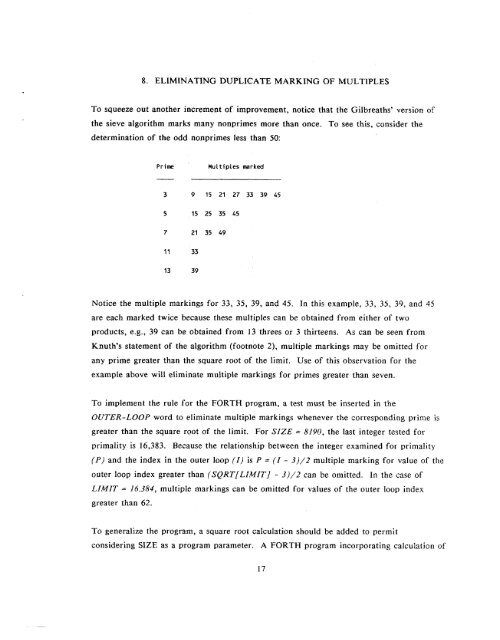Sieve of Eratosthenes benchmarks for the Z8 FORTH microcontroller
Sieve of Eratosthenes benchmarks for the Z8 FORTH microcontroller
Sieve of Eratosthenes benchmarks for the Z8 FORTH microcontroller
Create successful ePaper yourself
Turn your PDF publications into a flip-book with our unique Google optimized e-Paper software.
8. ELIMINATING DUPLICATE MARKING OF MULTIPLES<br />
To squeeze out ano<strong>the</strong>r increment <strong>of</strong> improvement, notice that <strong>the</strong> Gilbxeaths’ version <strong>of</strong><br />
<strong>the</strong> sieve algorithm marks many nonprirnes more than once. To see this, consider <strong>the</strong><br />
determination <strong>of</strong> <strong>the</strong> odd nonprimes less than 50:<br />
Prime Multiples marked<br />
3 9 15 21 27 33 39 45<br />
5 15 25 35 45<br />
7 21 35 49<br />
11 33<br />
13 39<br />
Notice <strong>the</strong> multiple markings <strong>for</strong> 33, 35, 39, and 45. In this example, 33, 35, 39, and 45;<br />
are each marked twice because <strong>the</strong>se multiples can be obtained from ei<strong>the</strong>r <strong>of</strong> two<br />
products, e.g., 39 can be obtained from 13 threes or 3 thirteens. As can be seen from<br />
Knuth’s statement <strong>of</strong> <strong>the</strong> algorithm (footnote 2), multiple markings may be omitted <strong>for</strong><br />
any prime greater than <strong>the</strong> square root <strong>of</strong> <strong>the</strong> limit. Use <strong>of</strong> this observation <strong>for</strong> <strong>the</strong><br />
example above will eliminate multiple markings <strong>for</strong> primes greater than seven.<br />
’To implement <strong>the</strong> rule <strong>for</strong> <strong>the</strong> <strong>FORTH</strong> program, a test must be inserted in <strong>the</strong><br />
OUTER-LOOP word to eliminate multiple markings whenever <strong>the</strong> corresponding prime is<br />
greater than <strong>the</strong> square root <strong>of</strong> <strong>the</strong> limit. For S UE = 8190, <strong>the</strong> last integer tested <strong>for</strong><br />
primality is 16,383. Because <strong>the</strong> relationship between <strong>the</strong> integer examined <strong>for</strong> primality<br />
(P) and <strong>the</strong> index in <strong>the</strong> outer loop (I) is P = ( I - 3)/2 multiple marking <strong>for</strong> value <strong>of</strong> <strong>the</strong><br />
outer loop index greater than (SQRTfLIMIT] - 3)/2 can be omitted. In <strong>the</strong> case <strong>of</strong><br />
LIMIT = 16,384, multiple markings can be omitted <strong>for</strong> values <strong>of</strong> <strong>the</strong> outer loop index<br />
greater than 62.<br />
To generalize <strong>the</strong> program, a square root calculation should be added to permit<br />
considering SIZE as a program parameter. A <strong>FORTH</strong> program incorporating calculation <strong>of</strong><br />
17
















